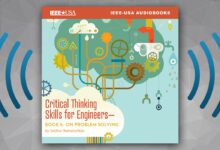
“Project management is probably the most important skill a young engineer can learn.”
These are the words of a man who should know. Harry T. Roman spent almost all of his long career directing and consulting on more than $100 million worth of projects and programs within Research & Development at Public Service Electric & Gas Company (PSE&G) in New Jersey.
Now, this IEEE Senior Member has written Project Management, an eBook that offers an ideal starting point for engineering professionals who want to learn the basics about this vital, career-building competency. In clear-cut, direct language, the author explains the concept of project management, offers steps to building a successful team, and warns how not to run a project team. He also provides historical background on the history of project management, including some interesting ties to technological icon, Thomas Edison.
| CALL FOR AUTHORS IEEE-USA eBooks seeks authors to write an individual eBook or a series on career guidance and development topics. If you have an idea you think will benefit members in a particular area of expertise, please email your proposal to IEEE-USA Publishing Manager Georgia C. Stelluto at g.stelluto@ieee.org. |
Roman believes strongly that project management skills are highly prized in any organization. He writes, “Engineers who can develop new plans for critical products, services, internal process improvements and special-needs technologies; and then combine, manage and lead others to make these things happen, is never going to fear unemployment.”
Recalling his first large project in 1973–designing and building one of the first interactive graphical user interfaces for running and analyzing electrical system load flow–he describes the overall experience as “love at first sight.”
The project included getting the funds approved, assembling the team, managing the work, working with vendors, tracking progress, testing prototypes, and training other employees how to use it. The three-year endeavor, which cost $300,000 at the time, hooked him on project management. After PSE&G incorporated project management as part of everyday company operations, Roman transferred to the R&D department so he could do this all the time.
In what is perhaps the most valuable chapter in the eBook, Roman details what he believes are the steps to a successful project team. It starts with identifying and selling the problem that the project team will address. The author warns these tasks sound easy enough, but are full of potential pitfalls. He encourages readers to make sure the project being recommended meets these five criteria: It must be a problem the company wants to solve; it has value to senior management; it offers enough tangible benefits; the solution can be achieved within a reasonable timeframe; and it is compatible with the company’s investment philosophy.
Roman emphasizes that selecting the right team members is critical to any successful project management team. Each person must be a high-value participant, one who will commit to the team’s goals. “Corporate departments that support your work will likely offer some team members,” he writes, “”¦a great thing, because it helps to cement support and focus.”
The author cautions that team members should be able to address–collectively and individually–both the “hard” and “soft” aspects of the project. “Hard” aspects include technical and economic requirements, while “soft” ones include environmental impacts, sociological considerations, legal impacts and, if the product or service will be offered worldwide, any cultural issues.
Another facet of being a successful project manager is to ensure that each team member buys into the project. Roman advises explaining to them in detail the value of the project to the company, as well as all the tangibles and intangibles–including what the competition is, or is not, doing. He also recommends making it clear the team will be performing a “360-degree walk-around analysis of the problem,” to encourage each person to think broadly and deeply about the problem at hand.
In the chapter titled “How to Ruin a Project Team,” the author lists a dozen ways a project leader can derail success. While almost all these missteps seem fairly obvious, Roman warns that they are based on real instances where project teams failed. These blunders include: failing to achieve the team’s consensus on the mission and goals; monopolizing discussions, thereby depriving the team of problem ownership; and neglecting to discourage negative talk, wrong attitudes and the “this-will-never-work” mindset.
A chapter on project management history points out that Thomas Edison pioneered his multi-disciplinary approach to problem solving by encouraging team-based innovation. First used in the 1870s in Edison’s legendary Menlo Park, New Jersey labs, the concept later demonstrated to businesses how to successfully integrate R&D with new product development.
“Before he died in 1931,” notes Roman, “most major companies in the United States had inaugurated their own commercial R&D facilities–changing forever the business model of the corporation.” He explains that Edison employed a variety of experts and technicians, combining them onto teams empowered to solve problems that Edison himself assigned to them. Free to find solutions based on their own initiative and with lab space and materials from a well-equipped stockroom, the teams went on to achieve new inventions and innovations.
Harry Roman is an IEEE Senior Member who worked for 36 years, almost all of them in R&D, for PSE&G, the largest utility serving New Jersey. He has also taught graduate-level R&D project management courses at the New Jersey Institute of Technology. Roman holds 12 U.S. patents; and in 2005, he received the Inventor of the Year Award from the New Jersey Inventors Hall of Fame for his application of mobile robots in hazardous work environments.
Project Management is available for $1.99 for IEEE members and $3.99 for non-members at https://ieeeusa.org/product/project-management/.






